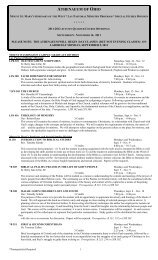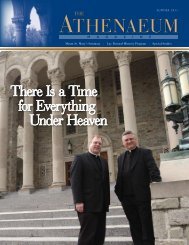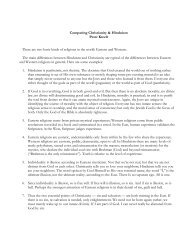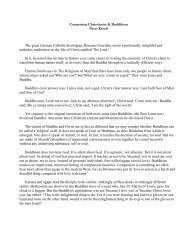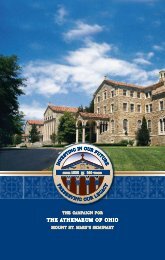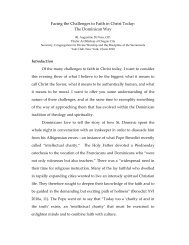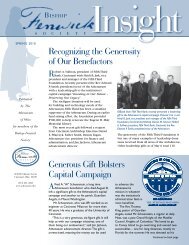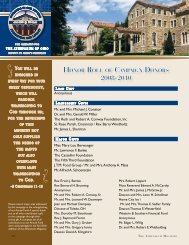Notes from Gathered for the Journey Six (6) essays David McCarthy
Notes from Gathered for the Journey Six (6) essays David McCarthy
Notes from Gathered for the Journey Six (6) essays David McCarthy
Create successful ePaper yourself
Turn your PDF publications into a flip-book with our unique Google optimized e-Paper software.
Some insights:Salvation is social—―it is certainly personal, but not <strong>the</strong> possession of individualsper se.‖Grace is never coercive, but an invitation to liberty. (Au<strong>the</strong>ntic freedom in truth)Salvation is freedom <strong>from</strong> self-centeredness—freedom ―<strong>from</strong> <strong>the</strong> idea that life(not to mention salvation) is about me (or about me and God)‖. (48)Sin is a ―deliberate rejection of God‘s will <strong>for</strong> us, and in salvation we are saved<strong>from</strong> our turning away <strong>from</strong> God.‖ (48)Note: ―our reconciliation is becoming part of God‘s love <strong>for</strong> <strong>the</strong> world. Love, <strong>the</strong>n,cannot be imposed.‖ (emphasis added, p.48) (see here relationship of au<strong>the</strong>ntic humanlove and freedom.)Not merely Human Love in Large Letters—Uniquely DivineNot merely like human love—we can be selfish, after all; in grace we transcend.―God‘s love is an invitation of friendship through God‘s self-giving—giving uswhat we cannot achieve on our own, a share in God‘s own life.‖<strong>McCarthy</strong> names <strong>the</strong> foundation of God‘s love and life in <strong>the</strong> Church: The key is<strong>for</strong>giveness in <strong>the</strong> Church (Sacrament of Reconciliation; Eucharist). (49)III. The Good News of Easter(pp. 49 – 54) <strong>McCarthy</strong> takes <strong>the</strong> previous insights and fills <strong>the</strong>m out in <strong>the</strong> context of<strong>the</strong> Easter Vigil.Liturgy is per<strong>for</strong>mative—we become what we do.The language of liturgy—a system of communication—grew up around acommon lifeMoral life and Easter—we learn a new language to express our deepestconvictions and color <strong>the</strong> lens through which we see and interpret <strong>the</strong> world.We liturgically enter into <strong>the</strong>mes of sin, journey, call, recondition and so <strong>for</strong>th—central to <strong>for</strong>ming a Christian moral character. (think of all <strong>the</strong> symbols andsymbolic actions in <strong>the</strong> Easter Vigil)We evoke <strong>the</strong> New Jerusalem ―where humanity will be trans<strong>for</strong>med and a newkingdom will be established, a dominion of life and grace.‖ (50, quoting JamesDonohue, C.R.)We enter into <strong>the</strong> covenant and its witness to salvation and to a steadfast God.The Witness of <strong>the</strong> CrossThe Cross—―<strong>the</strong> crucifixion is <strong>the</strong> end of all sacrifice. Jesus Christ‘s life anddeath are <strong>the</strong> practical and concrete matrix (or location) of God‘s relationship to<strong>the</strong> world.‖ (51)Redemptive level of <strong>the</strong> Cross: moment of praise, thanksgiving and communion.Fundamental Moral Theology Page 4 of 54Class <strong>Notes</strong> – Fa<strong>the</strong>r Michael Seger



